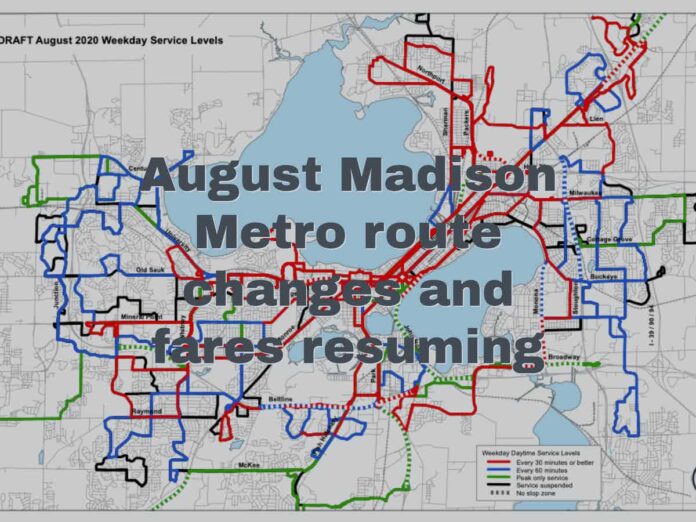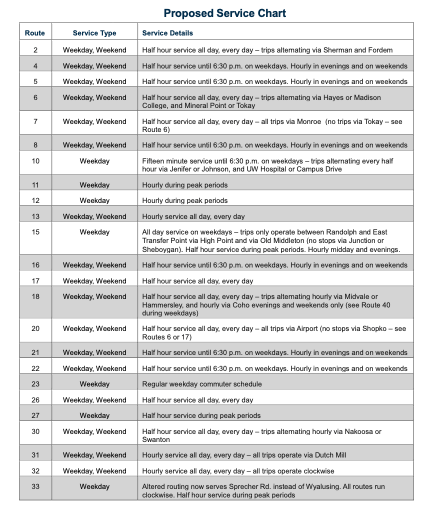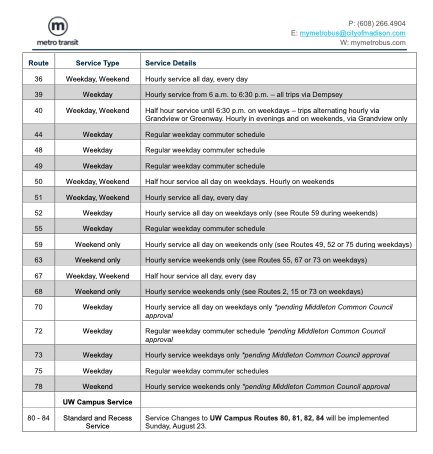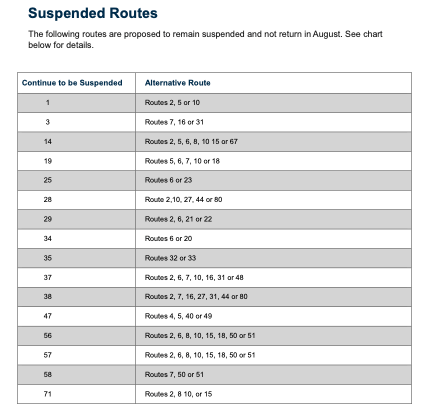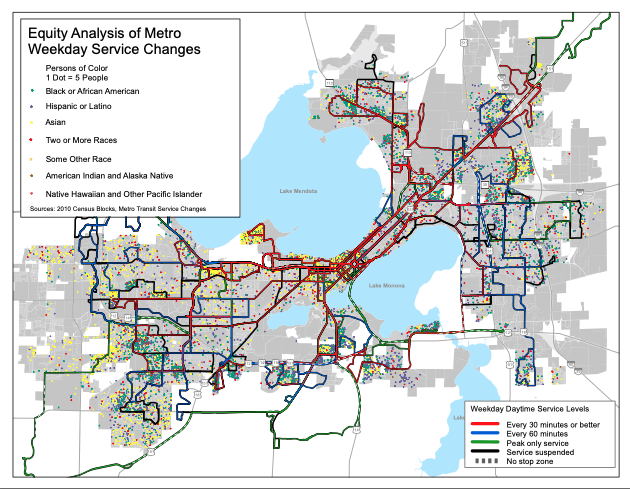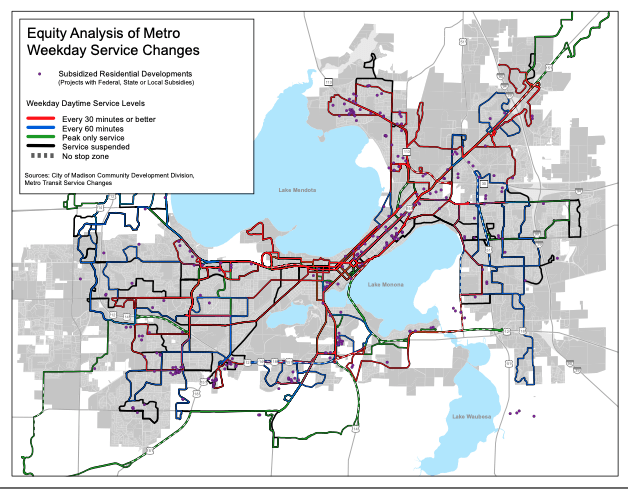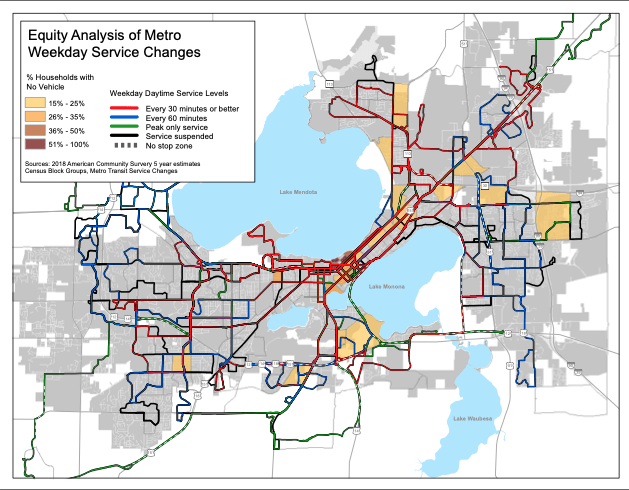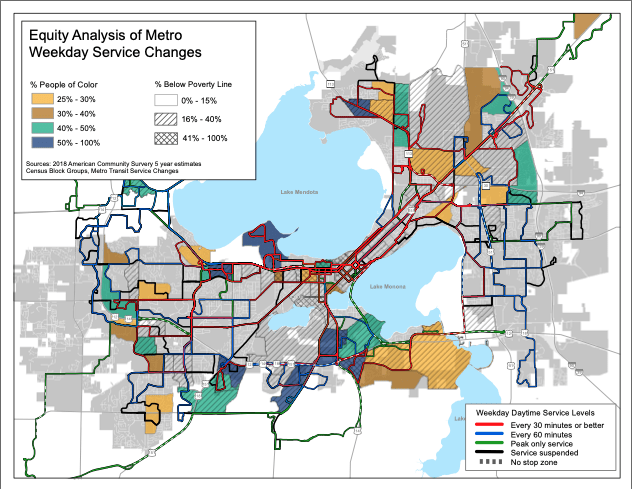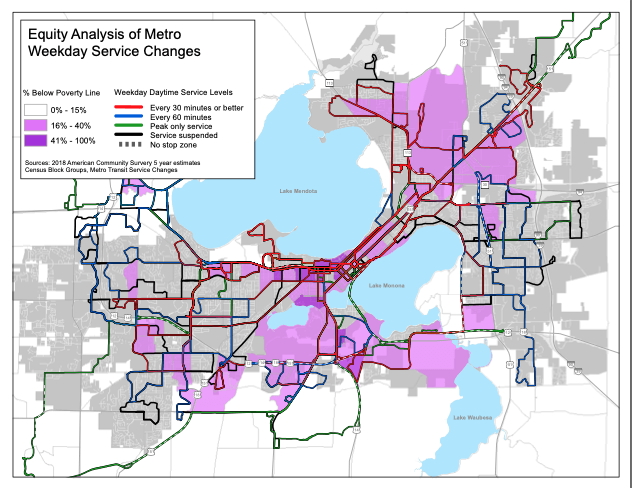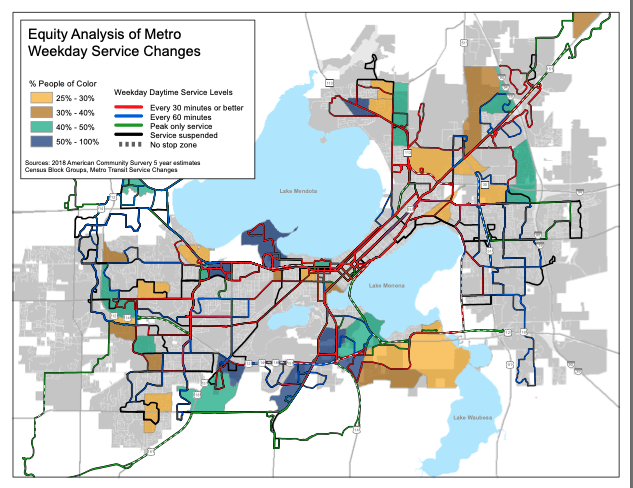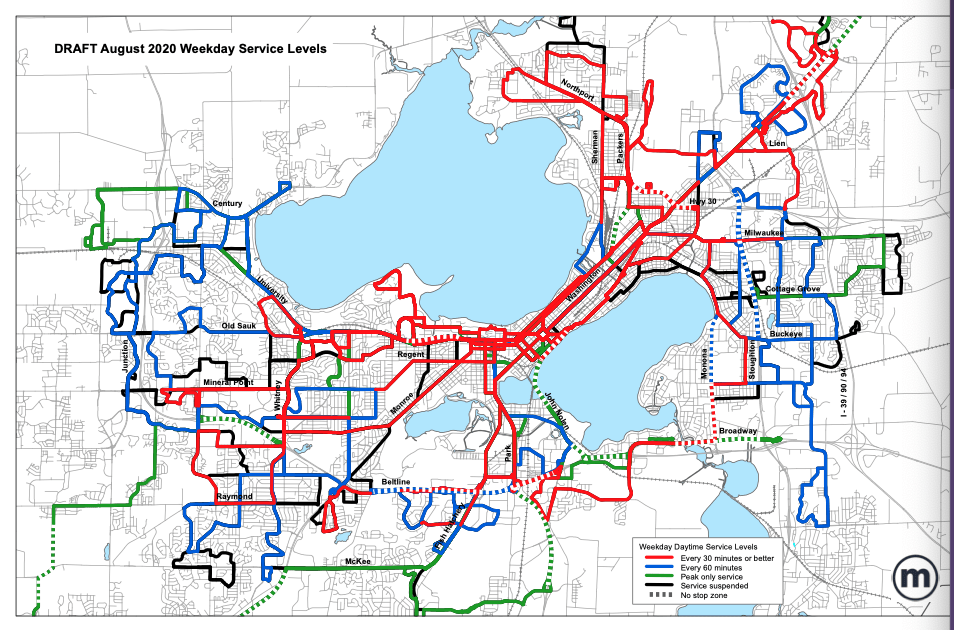There was a 25 minute presentation/discussion at the Transportation Commission on Tuesday, and here is what they decided and what you can expect for changes in August, including when fares might return.
You can watch the meeting here:
Agenda is here, the agenda item is #6, Approval of Metro Transit Service Restoration Plan and it has the following attachments:
- Increased Service Plan – Final (18 pages)
- Feedback on Service Updates (5 pages)
- Paratransit Increase Service (1 page)
And a quick aside, there have been two vacancies on this commission since January. Hmm. If you’re interested, apply here.
PUBLIC INPUT (OR LACK THEREOF)
The chair Ann Kovich explains that normally they would have a brief presentation from Justin (Stuehrenberg, the new Madison Metro Manager) and the Metro staff, then we would go to any public speakers, they don’t have any. She says they have a lot of public feedback, they just sent out an updated listing of the public feedback about an hour ago, so they have been recieving a lot of public feedback, but no one is there for the meeting. She asks Justin to give a brief presentation on what is different from what they heard at the last meeting.
Stuehrenberg (its going to take me a while to get that right!) shares his screen, the document he is showing is this one –Increased Service Plan – Final – and it has detail what was lacking at the last meeting. These are the changes they hope to implement on August 23rd. They don’t have time for a public hearing before these service changes are implemented, but they are committing to a public hearing later in the year, most likely in the October/November time frame, to gather additional feedback around the changes that have been made and to make further tweaks. Things are moving and changing so quickly that there will almost assuredly be some changes we have to make and so that will give us a good opportunity to do that with the public hearing comment. Stuehrenberg says he believes strongly in the public process and so not having a public hearing is not what he would have chosen, but reality of what we have here is that because things are moving so quickly and because the UW is planning to re-open at the end of August, at least in part, there is no way they can carry the number of people that will be flooding our system with the service that is out on the street today, so they need to make some pretty quick service enhancements so they are in a position where they are not constantly turning people away. That is the justification for why we are making these changes now without that process.
They did send out a request for feedback, there was some feedback included in the memo they posted last week and they sent some more this morning. He will summarize on a couple of the bigger routes that were subject of the feedback.
PRESENTATION
Proposed Service and Suspended Routes
He doesn’t go through route by route that is summarized in the chart.
For the most part they are sticking with the existing route network from pre-pandemic. Some routes are not being restored. Those would stay suspended for now. Some others may not be restored to full strength, they may be partially restored. He asks if there are any questions, he then shows the routes that remain suspended.
He says several of these routes are served by other routes nearby. They tried to minimize the amount of area complete unserved.
Equity Analysis
They did do an equity review and they are highlighted in several maps.
Two areas they have identified as potential concerns. One is on the west side, was Tree Lane, which is about 1/3 of a mile north of Mineral Point Rd and the other was Thompson Rd on the East Side, about 1/4 of a mile from Milwaukee Street. Both of those areas, even pre-pandemic, saw pretty low service levels, which showed up in the boarding activity. The boarding activity in both of those areas was pretty low, less than 10 per day. Because they were closer to other street that had better service, he thinks people were already walking to those streets to get better service, so he would assume that would continue. Those were two areas that were particularly high minority population and persons of color but that would not be getting service restored. Those are highlighted in the maps, both for persons of color and low income areas.
Feedback
There was a handful of feedback, 17 comments in this version and 22 in the version that was circulated this morning. There were a couple routes that jumped out that have more comments than others. One is route 35 which is on the east side, part of it goes across I-39 that would not be getting restored and there were several comments around restoring service there. That is an area that does not have other services that are very convenient, people would have to walk across I-39 to get to the other route (32) but that area, there is not an easy way to serve that area without restoring an entire route and the boardings on that loop were less than 10 per day. It’s not nothing, but as we look to prioritize areas where we need to restore capacity to make sure we don’t have too many people on the bus, that was an area we suggested was not apprpriate to restore service to.
Some of the others were on the far west side, over by the beltline, some of the service on Junction Road and Demming Way on the far west side. Those are areas where several commenters requested that route 15 continue to serve, however while route 15 is not serving that area, other routes will continue to serve it. That area doesn’t lose its service entirely, but for some of the trip destinations for people in that are they will be forced to transfer now.
Those are the larger buckets of comments but he’s be happy to discuss more specifics.
Tim Sobota from Metro Transit says that route 35 east of interstate 39 is an area where passengers would need to be walking on a bridge that was upgraded with sidewalk, given our current situations, the Southdale Neighborhood, south of the beltline between Park St. and Rimrock also has a bridge and west of there between Seminole Highway and Nakoma Rd and Verona Road there is a pedestrian road over the beltline that connection route 18 service on the south side of the beltline with the residential areas on the north side of the beltline there. And to a lesser extent there is the beltline bridge on Todd Drive and Fish Hatchery Rd that connects the 18 services on the south side with some of the commercial properties and public restaurants on the north side of the highway there. Those are all similar situations where there is a built pedestrian environment to cross highways. That would be the one aspect for that specific area. Cottage Grove Rd is similar with the bridge over the beltline with the sidewalks – the one that has been a concern historically is the two bridges that cross the interstate at Milwaukee St. – that was part of the restoration effort to serve the neighborhoods east of the interstate along Milwaukee St just because there is not a pedestrian facility to cross those bridges.
Mike (also Metro Staff) adds that the map has a legend and ther red lines are 30 minute service or better, blue lines have service every 60 minutes but in some cases better, its mostly hourly service throughout the day. The green lines are peak only service.
Another quick thing to add is that a lot of the service they are not restoring is the commuter service, rush hour only service, its not as convenient to block and schedule that and also a lot of the people that are used to the one seat ride to downtown or the UW Campus are not going to have to transfer and that’s just sort of what we have to do to make this work.
Ken Streit asks where they are comparing July ’20 with July ’19 in general. I know its summer and covid and all that, but where is ridership?
Stuehrenberg says its down substantially, but he doesn’t have the specific numbers, but its down roughly 80% or so. Another staff person says they haven’t been paying attention to those reports either.
Ken ? says on the red routes, which have the most boardings per day, do you anticipate that given the restraints we have as far as the number of people on buses and things like that, will they be “crowded”, not in the usual winter crowded kind of thing, but will we be needing to pass by people or would we have to put on more buses if UW comes back?
Stuehrenberg says that is what they are trying to avoid – passing people by, but the reality is that they don’t know.
Streit? agrees, with classes on line, we don’t know.
Stuehrenberg says they are trying to set themselves up for success as they can best predict is, in terms of restoring some of the service to campus because those will be some of the first folks that come back to the service, especially once the campus re-opens and especially the students.
Streit says right now instead of getting the drivers out to the end of the line and they just jump in the seat and take over a bus, we’re having drivers bring the busses all the way back to be cleaned and bringing out new buses and that means we are using more buses per passenger mile than we ever have before. Will we have any spare capacity to add vehicles in case we do on some of these lines, wind up having to pass by 10-20 people.
Stuehrenberg says they will likely have spare vehicle capacity, the question is do we have enough operators. We’re trying to structure it in a way where we have some slack in our schedules so that we have an extra board – extra board is the folks that wait to fill assignments when someone calls in sick or if there is a road bus that we need to send out, so we are trying to structure the service in a way that we are not stretching ourselves so thin that we don’t have any capacity to do that kind of stuff. Our intent is to have a little bit of capacity to address those sorts of things, but obviously there is a limit to that, if we need to double the amount of buses going to campus that will not work but if we need to add one or two certain times of day that might work.
Streit says in Chicago they had “bumper buses” and instead of revising routes they just put extra buses on the route so people weren’t left standing. He’s hoping we might have 10 spare buses and drivers in case you want to just do that some day we have the capacity to do that, maybe just bring it half way through, not through the end of the route.
Stuehrenberg says they plan to have some capacity to do what you are saying.
Harald Kliems asks if in terms of traffic volumes have you made adjustments to schedules to take into account that buses don’t get stuck in traffic, would that help you free up some capacity?
Stuehrenberg says that they haven’t made changes to running time, the reality is that the running times were pretty tight before the pandemic as traffic continued to get worse and worse, so this is allowing us to be a bit more on-time. There’s not a lot of time to recoup.
Sobota says that with the timed transfer point system, if the route 4 bus was at the south transfer point and the north transfer point is not taking an hour you would eliminate a bus if it took a half hour instead of an hour, to the extent that they would be operating every 30 minutes and we’re not saving 30 minutes in our cross town travel times. We have looked at running times – one addition that we didn’t do was the route 15 between the east transfer point and Mineral Point Rd on the west side that historically that running time from East to Mineral Point Rd was over an hour and we’ve brought that down to just under and hour in order to be able to use a trip an hour, if we can make it in under an hours from east side to west side and west to east, we can use 2 buses and we don’t need to put a third bus on there. So we have sought efficiencies in that respect. And are moving forward with those. Where its not dependent on that transfer point system and can benefit and save resources.
Kliems asks about communicating the changes and we talked a lot about how people can walk a little bit further to get to a different line, and I think people who regularly use the bus system might figure that out, but what about having posters on each of the bus stops that are currently not served with “next stop, walk over here, this is the schedule” to help people make the transition to the new system more easily.
Stuehrenberg says because things are changing so rapidly its going to be difficult to be able to put new schedules at every bus stop, so there is so much they can logistically do.
Mick Rousch says they are not going to print a ride guide, but they are working on a 15 page mini-ride guide for that section and we will make a ride guide they will put on-line and they will distribute that the best they can. They will put posters at the transfer points and get schedules at the Cap Square, ? and all the real big stops and they’re going to start crackin’ on it tomorrow if you approve it tonight and start getting the word out. They will try to do as many stops as they can. It won’t be something we blow off, we’ll be working on it the rest of the summer.
Sobota says that he has been working on and has just submitted to google maps the proposed schedules in its map form, part of that is done accurately, but making sure that gets out on all the platforms. That is the one things he has been trying very hard to do for users who may have access to mobile or computer based technologies to have an accurate representation of the system status in the open data areas. And as Mick was describing, as far as getting those out and getting them out, the deal is for lead time for third party developers to incorporate those into the platforms and transitioning and pivoting to the printed out plan. We are working to pull that data out of our databases and page formating to get them into schedule displays and printed format for additional ways people use the information (?)
Grant Foster sasy they were hoping to be increasing service this year before COVID and he appreciates the commitment to have a public hearing later in the year. He says if they are able to publish some of the content you are doing, the real base stuff, via press release so it shows up in the updates section of the city site. It’s a little out or reach and that is what he relies on to amplify messages to his constituents. I know you have your internal subscribers as well, but he thinks there are a number of riders that are not getting that message. He did see some of the communications via Facebook and it looks like there is pretty good social media campaign to get the word out but he would recommend pushing some of it out through that other channel as well.
Mick says you got it, no problem.
Bill Bremer says that when UW starts you’re going to have to be very nimble that first week or two weeks because I think the students when they want to go home, they want to go home and as a rider before the pandemic during those times coming from UW campus they were shoulder to shoulder and that is going to be a real challenge as far as accommodating the ridership. Will you plan on talking to the drivers, they will probably give you more insight on specific times of when the challenges will be, perhaps faster than the data you can collect. He thinks that would be some good insight, have them fill out forms or something, the first week or two of school are when the challenges are really going to show up.
Stuehrenberg are asked to radio back to dispatch at any time where they start to have capacity issues so dispatch is logging those events, but you’re right, those first two weeks will really be the test because things will suddenly start to change. We’ve gotten into a bit of a rhythm now, through the summer where things are incrementally changing but come the end of August its just going to all blow up so, we will need to amplify that message that drivers need to radio in whenever they are hitting capacity issues and talking about areas where maybe we are not hitting that limit but getting close so we can be prepared for those instances.
Bremer asks how the mandate of masks is being received by customers.
Stuehrenberg says that generally from talking to drivers it seems like most riders are using masks now, the number I heard was 90% or so. We have asked our drivers to remind people if they get on without a mask, but if they refuse to let it go. We don’t want it escalating into a confrontation of some sort. We are also providing masks on the bus for those who need them. That turned into a bit of a to do the first couple days where Mick and his teams put together some boxes that we mounted to a pole and we could pull the masks from, but we put too many out there and people jumped on the bus and scooped them all up and went to sell them. So we have gotten that a bit under control where we leave a few there and the rest are in the drivers compartment and they can call supervisors to come out and replenish. So it seems like that has calmed down a bit. Overall, compliance is better than I had thought it would be.
Bremer asks when they anticipate going to front door entry? Which means a return to fares.
Stuehrenberg says they expect in mid-August to have the plexiglass barriers installed and then at that point they would start collecting fares probably somewhere in late August or September 1st, they haven’t settled on a date, it depends upon the progress of that work.
Bremer says he imagines that would receive quite a bit of publicity then?
Mick says they have gone through more than their whole supply that they got sent to them, which was about 10,000 masks. We sent over the last bit today. We found some disposable ones on-line that are a good price and we’re going to order more, but we’re going to run out for a little bit, but it was very popular, people were, even the ones that were taking too many, I think overall it was received very well and he heard 90% as well. He was at a transfer point last week and saw everyone but one person wearing a mask, so he thinks it is going very well, much better than he thought it would.
MOTION
Streit says recognizing the need to be flexible, including that UW will have schedules to go 24 hours a day to accommodate the classroom space, he moves approval of the plan scheduled for August 23rd.
Bremer seconds.
No further discussion. Chair Kovich says that last month their motion included the need for “robust communication” and I think you heard that tonight, its critical that we use every possible resource that we have to get the message out, not only about the route changes but for when they start charging fares again. You’ve done a good job of trying to reach everybody and there was some additional suggestions that were made tonight that were very good and if anybody thinks of anything between now and whenever, just shoot Justin and email or Mick or whomever or Patrick and he’ll get the message on to them. We have to use different means to communicate these days than what we have been able to do in the past.
No further discussion. No objections to unanimous consent vote.
It passes.
DISCUSSION

